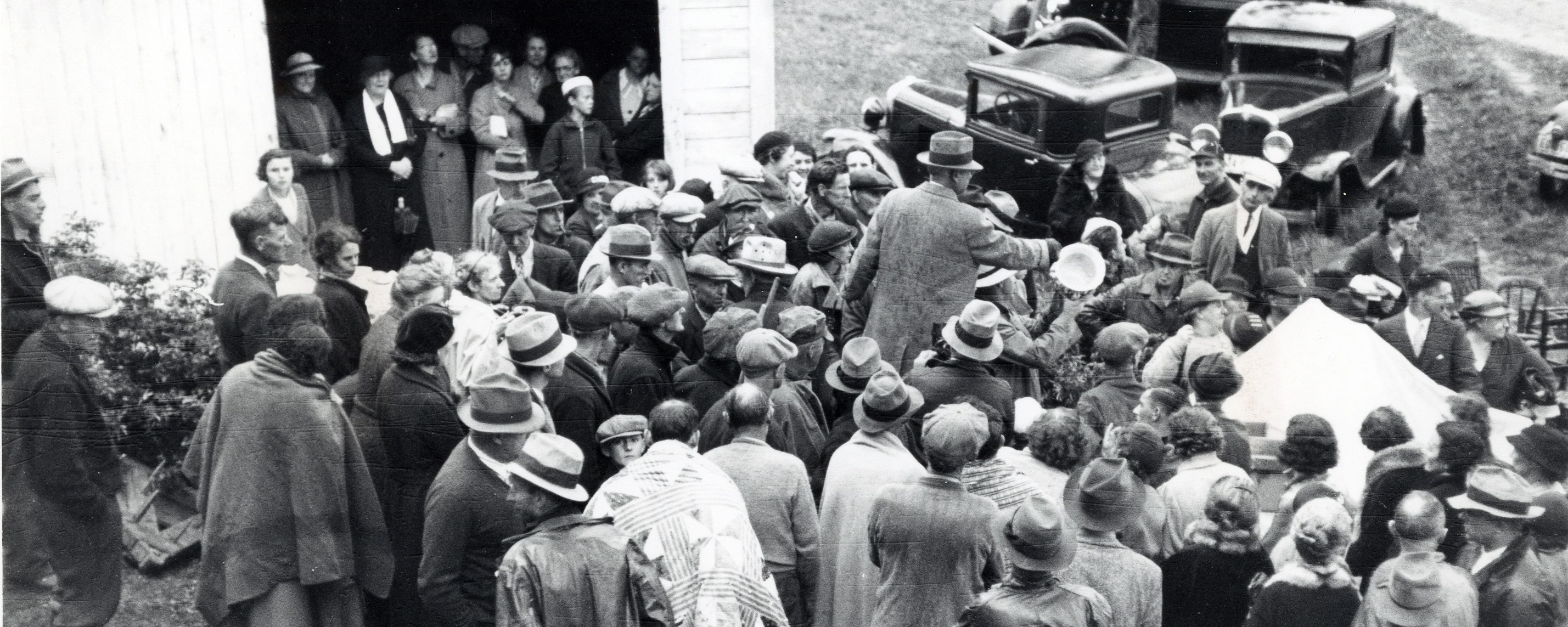Vermont in the Great Depression, 1929

Oral history transcriptions
Click a name below for more information. All transcripts are in PDF format.
Background information
Until recently, little has been written about Vermont during the Great Depression. Two major and now classic scholarly works addressed some aspects of the era. Richard M. Judd's New Deal in Vermont covers a broad expanse of time and focuses on the major political events and the players who shaped New Deal legislation in Vermont. Elin Anderson's We Americans offers a remarkably insightful look at patterns of social interaction between Burlingtonians of varying social and ethnic identities ca. 1930, but does little to convey the overall reality of Depression-era life throughout the state. What was the nature of suffering, misery, despair—in sum, what was it like to have lived through this devastating event and the subsequent years? Vermont historians have yet to fully address this question, although a few more recent works help fill in the gaps.
The most interesting approach to understanding the impact and effects of the Great Depression on the lives of Vermonters is to examine the contrast between rural and urban communities in the state during that era. Those hardest hit were urban dwellers in general and laborers in particular. Judd points out that the marble, stone, and machine tool industries in Vermont came to a crashing halt during the Depression. Workers in the urban industrial centers—most notably Rutland, Barre, Burlington, Winooski, Springfield, and Windsor—bore a disproportionate share of Depression-era misery.
Rural communities and those tied to agriculture likewise suffered the consequences of a nationwide and worldwide depression, but in different ways. Farm families, scattered throughout Vermont’s agricultural towns and villages were not immune to the economic depression, but had different resources and strategies for coping with them. The folklore of the state insists that Vermont’s subsistence farming and small local markets had changed so little over time that farmers hardly noticed the Depression. A book like Up in the Morning Early: Vermont Farm Families in the Thirties, by Scott E. Hastings, Jr. and Elsie R. Hastings (1992), based on photographs and interviews from the 1930s, implies that agricultural technology, techniques, and economy had changed little since the late nineteenth century and therefore felt little impact from the collapse of the wider national and global economy.
Popular writers, such as Dorothy Canfield Fisher and Walter Hard, likewise wrote essays suggesting that Vermont farm families hardly noticed the Depression. Judd reports that “By 1930, subsistence farming was no longer taken seriously by census takers, agricultural experts, or bureaucratic takers of the economic pulse, but its techniques and habits were ingrained in most Vermonters with a hill country background.” And George Aiken, in his harangues against the New Deal, wryly observed “that the fact remains that here we are, most of us healthy and well-nourished, comfortably warm and self-supporting—‘statistically bankrupt,’ . . . but actually solvent.” These people, the story goes, accustomed to a low standard of living and adept at making do with what they had, seem to have had few problems.
The statistics, dismissed by George Aiken, tell a somewhat different story. The industrial economy of the state did, indeed, suffer from the effects of the Depression. The value of industrial products dropped more than 50 percent in five years, from $142,522,547 in 1928, to $80,602,968 in 1931, and $56,623,538 in 1933. In the same period the number of industrial workers fell from 27,421 to 15,083; total wages from industry dropped from $33,809,987 to $12,456,113; and the number of industrial plants fell from 927 to 530.
But agriculture, too, suffered enormously. Income from the sale of fluid milk, Vermont’s most important agricultural product, dropped more than half from 1929 to 1933, in some places to 2.67 cents per quart—far less than the cost to the farmer for feed and equipment. The decline in demand for agricultural products that farmers had used to supplement their incomes, such as potatoes and lumber, further reduced agricultural workers’ purchasing power to its lowest level since 1877. Many farmers sold out—more than 1,500 farms went out of business in the decade after the Great Crash of 1929, putting much of the land out of cultivation, and by 1930 the proportion of unimproved farmland had risen to 60 percent. The total number of people employed in agriculture in that same period declined from 27 percent to 22 percent of the total work force.
The hardships of rural communities may have been less visible, and rural people may have had somewhat easier access to resources such as food and heating fuel than their urban neighbors, but as the Farm Security Administration photographs of the period, selected and with commentary by Nancy Price Graff (2002) shows, their suffering was not less real or dismal than those who depended on industrial or commercial work.
What allowed many Vermonters to survive in both rural and urban areas, were the skills and tradition of self-reliance, combined with cooperation, barter, and sharing resources.
—Jeff Potash, Gene Sessions, and Michael Sherman
For further reading:
Elin Anderson, We Americans: A Study of Cleavage in an American City (Cambridge, Mass.: Harvard University Press, 1937; reprinted, New York: Russell & Russell, 1967).
Nancy Price Graff, Looking Back at Vermont: Farm Security Administration Photographs, 1936-1942 (Middlebury, Vt.: Middlebury College Museum of Art, 2002)
Sarah M. Gregg, “Can We ‘Trust Uncle Sam’? Vermont and the Submarginal Lands Project, 1934-1936, Vermont History 69 (2001): 201-221.
Scott E. Hastings, Jr. and Elsie R. Hastings, Up in the Morning Early: Vermont Farm Families in the Thirties, (Hnover, N.H.: University Press of New England, 1992)
Richard M. Judd, New Deal in Vermont: Its Impact and Aftermath (New York: Garland Publishers, 1979).
Michael Sherman, Gene Sessions, P. Jeffrey Potash, Freedom and Unity: A History of Vermont (Barre, Vt.: Vermont Historical Society, 2004), 432-447.
Citation for this page
Woodsmoke Productions and Vermont Historical Society, “Vermont in the Great Depression, 1929,” The Green Mountain Chronicles radio broadcast and background information, original broadcast 1988-89. https://vermonthistory.org/vermont-in-great-depression-1929